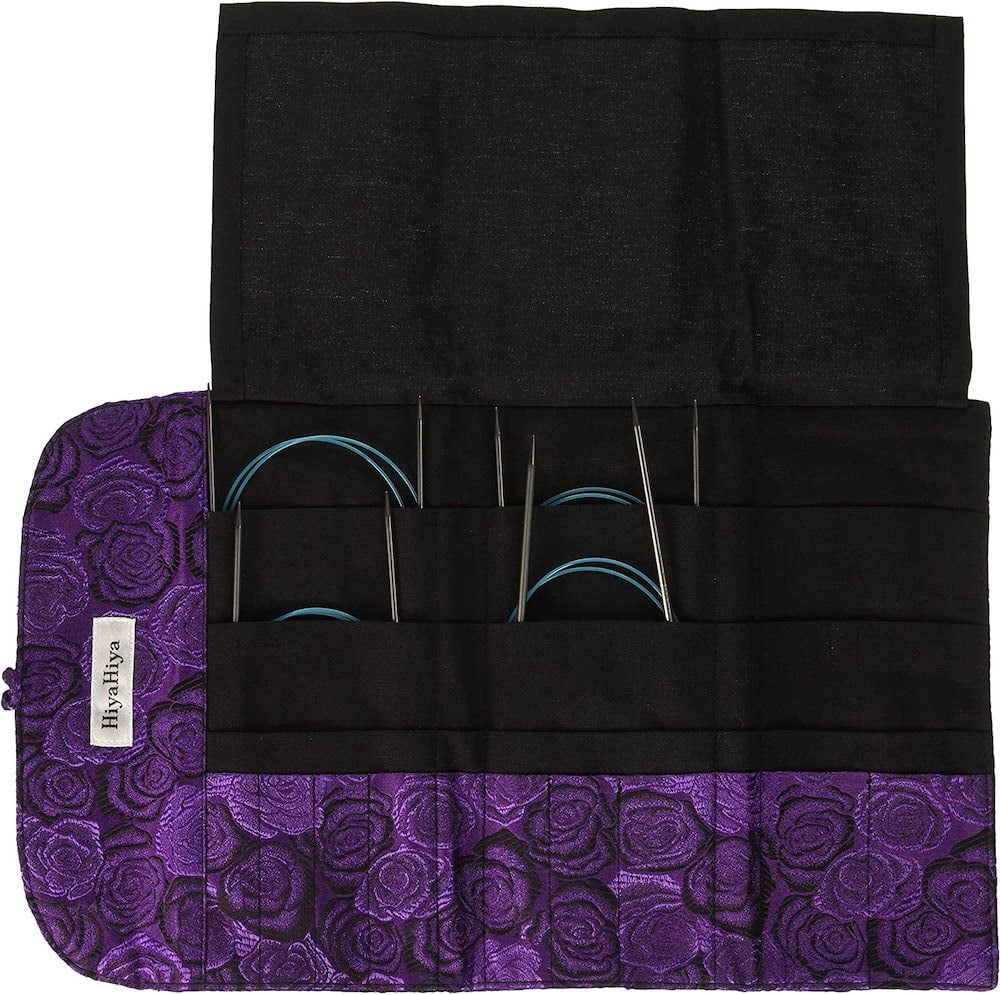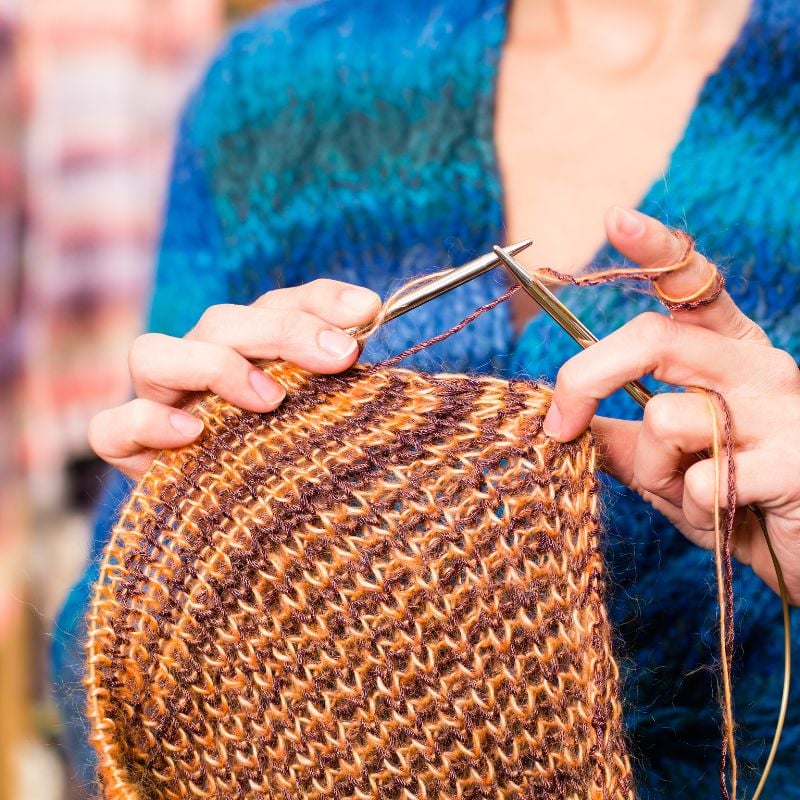13 Best Knitting Needles For Sock Knitting
THIS ARTICLE CONTAINS AFFILIATE LINKS THAT SUPPORT HANDY LITTLE ME CONTENT AND FREE PATTERNS.In this blog post, we will see the best knitting needles for sock knitting.
One of the most important knitting tools is your knitting needles.
And when it comes to knitting socks you might need something different from your basic straight knitting needles.
Whether you are knitting toe-up socks or cuff-down socks a pair of circular knitting needles or a set of DPNs (double-pointed needles) are your best choice.

Do You Need Special Needles To Knit Socks?
You don’t necessarily need special needles to knit socks, but there are certain types of needles that are commonly used and can be beneficial for sock knitting.
Here are some options:
- Double-pointed needles (DPNs): DPNs are a traditional choice for knitting socks. They come in sets of four or five-pointed needles and allow you to distribute your stitches across multiple needles. DPNs work well for small circumference projects like socks and provide flexibility in managing your stitches.
- Circular needles: Circular needles are another popular option for knitting socks. They consist of two needle tips connected by a flexible cable. Circular needles are versatile and can be used for knitting in the round, either using the magic loop technique or two circulars technique. They eliminate the need for DPNs and can be more comfortable to work with.
- Short circular needles: Short circular needles, typically ranging from 9 to 16 inches (23 to 40 cm) in length, are specifically designed for small-circumference knitting like socks. They provide a compact and comfortable way to knit socks in the round, eliminating the need for DPNs or longer circular needles.
- Interchangeable needle sets: Interchangeable needle sets offer versatility by allowing you to switch needle tips and cables of various lengths. These sets often include a range of needle sizes, including smaller sizes suitable for sock knitting. They are an investment but provide flexibility for knitting different projects, including socks.
While you don’t need specialized sock needles, using needles specifically designed for small-circumference knitting can enhance your sock knitting experience.
It’s a matter of personal preference and finding the needle type and size that suits your knitting style and comfort.
Ultimately, any type of knitting needles that you are comfortable with and that work for the yarn weight and gauge of your sock project can be used to knit socks.

Is It Easier To Knit Socks With DPN Or Circular Needles?
The choice between double-pointed needles (DPNs) and circular needles for knitting socks depends on personal preference and the knitting technique you find more comfortable.
Both methods have their advantages and considerations:
Double-pointed needles (DPNs):
- Traditional method: DPNs have been used for knitting socks for a long time and are the traditional choice. They consist of a set of four or five needles with pointed ends.
- Flexibility: DPNs offer flexibility, as you can distribute your stitches across multiple needles and work with one or two needles at a time.
- Tighter stitches: Some knitters find that DPNs allow for tighter stitches, which can be advantageous for achieving a denser fabric, especially with finer yarns.
- Simplicity: Using DPNs can be simpler in terms of technique, as you don’t need to worry about a long cable or managing a loop of extra cable like with circular needles.
- Small circumference projects: DPNs are particularly suitable for small circumference projects like socks, where the stitches can be evenly divided across the needles.

Circular needles:
- Seamless knitting: Circular needles can be used for knitting socks in the round, allowing for seamless construction without the need for sewing or joining.
- Magic loop or two circulars: Circular needles offer versatile techniques like the magic loop or two circulars, which allow you to work on small circumference projects without the need for DPNs.
- Fewer needle changes: With circular needles, you only have two needle tips to manage, which can be more comfortable and reduce the risk of dropped stitches or stitches slipping off the needles.
- Cable length: Ensure that the cable length of your circular needles is suitable for the circumference of your sock project. Shorter circulars are often preferred for socks.
Ultimately, the choice between DPNs and circular needles for knitting socks depends on your personal preference, knitting technique comfort, and the result you wish to achieve.
Some knitters prefer the familiarity and control of DPNs, while others enjoy the versatility and convenience of circular needles.
It may be helpful to try both methods and see which one feels more comfortable and enjoyable for you.

What Is The Best Size Needle For Knitting Socks?
The best size needle for knitting socks depends on various factors, including your knitting style, yarn weight, desired gauge, and personal preference.
Here are some general guidelines to help you choose the appropriate needle size for knitting socks:
- Yarn weight: The needle size you choose should be suitable for the yarn weight you’re using. For lightweight or fingering-weight yarn, typically used for socks, needle sizes ranging from US 0 (2.0 mm) to US 3 (3.25 mm) are common. However, this can vary depending on your tension and desired fabric. Learn everything about the different yarn weights here – Yarn Weight Guide (+ Conversion Chart).
- Gauge: It’s important to achieve the recommended gauge for your sock pattern to ensure proper fit and size. Follow the gauge specified in your pattern, and if necessary, adjust your needle size to match the gauge. Swatching is recommended to determine the right needle size to achieve the desired gauge. Learn how to measure gauge here – How To Measure Gauge In Knitting
- Tension and fabric: Consider your personal tension and the fabric you prefer for socks. Some knitters may have a looser or tighter tension, which can affect their needle size choice. If you tend to knit tightly, you may need to go up a needle size to achieve the desired gauge and ensure a comfortable fit.
- Pattern recommendations: If you’re following a specific sock pattern, it may provide recommendations for the needle size to use. The pattern designer has likely tested the pattern with specific needle sizes to achieve the intended result. Following their recommendations can be a good starting point.
- Personal preference: Your preference also plays a role in choosing the best needle size. Some knitters prefer a tighter or looser fabric for their socks, and the needle size can be adjusted accordingly to achieve the desired feel and drape.
It’s worth noting that every knitter is unique, and individual tension can vary.
Experimenting with different needle sizes and swatching will help you find the best needle size to achieve the desired gauge and create socks that fit well and meet your preferences.

What Length Circular Needle Is Best For Socks?
When choosing a circular needle length for knitting socks, the most commonly used lengths are 9 inches (23 cm), 12 inches (30 cm), or 16 inches (40 cm).
The best length for you depends on your preferred method of knitting socks and the circumference of the socks you’re knitting.
Here’s a general guideline to help you choose the appropriate length:
- 9 inches (23 cm): This length is often preferred for knitting socks using the magic loop technique. It allows you to comfortably work on small circumference projects and provides enough length for the loop to be created between the two halves of stitches. It’s a good choice for those who enjoy using the magic loop method.
- 12 inches (30 cm): This length is versatile and can be used for knitting socks using various techniques, including the magic loop, two circular needles, or even double-pointed needles (DPNs). It provides enough space to maneuver your stitches and needles comfortably while working on the sock circumference.
- 16 inches (40 cm): This length is commonly used for knitting socks using the two-circular needles technique. It allows you to divide your stitches between two separate circular needles and work on each half independently. It’s also suitable for other small circumference projects.
Ultimately, the best length for your sock knitting needle depends on your personal preference and the technique you prefer.
If possible, you could try different lengths to see which one feels most comfortable and suits your knitting style.

The Sock Knitting Pattern For You
If you choose the perfect sock yarn and needles, check out these free knitting patterns to make your first pair of socks.

13 Best Knitting Needles For Sock Knitting
If you are ready to build your sock knitting kit take a look at this round-up of knitting needles that are ideal for socks.
Including small needles, tiny circulars, interchangeable circular needles, and double-pointed knitting needles.
Check them out and choose the best needles for you.
Knitter's Pride Karbonz Double Pointed Sock Needle Set
This double-pointed knitting needles set is the perfect choice for all of your sock knitting.
The metallic needles range from US 0 (2.0mm) to US3 (3.25mm).
Knitter's Pride Nova Platina Cubic 6" Double Pointed Needle
The knitter's pride double-pointed metal needles are excellent for comfortable knitting with pointy brass tips.
Lightweight, strong, and durable these needles are perfect for knitting socks and other small circular knitting projects.
Addi Click Turbo Interchangeable Needle Tips
Addi circular knitting needles are perfect for knitting circular projects like socks, cowls, hats, and sleeves.
Just add the cord to the interchangeable needle tip and you are ready to go.
Pony Bamboo Double Point Needles 20cm
These bamboo needles are ideal for all different types of knitting projects, especially socks.
This high-quality knitting needle set is a great addition to your knitting tool kit.
Plus the wooden needles provide an excellent grip and a smooth surface.
Addi CraSyTrio Fixed Circular Needle 21cm (8")
Using the same technology as circular needles, these CraSy Trio needles from Addi are an ingenious new way to knit socks.
This short circular needle pair can be a great gift for your knitter friends.
Pony Aluminium Circular Needles 80cm
An excellent set of fixed knitting needles, for all of your tube projects like socks, hats, and cowls but the flexible cord allows you to carry bigger projects as well.
KnitPro 15 cm Symfonie Double Pointed Sock Needle Kit, Multi-Color
A great sock knitting kit you can easily get from Amazon to make all of your sock knitting dreams come true!
CHIAOGOO Red Ribbon Double Point Stainless Steel Needles Set, 6-Inch
A set of stainless steel knitting needles to make an easy sock pair.
Plus it comes with a beautiful case.
Woolybaabaa HiyaHiya 40 Inch Sharp Stainless Steel Circular Knitting Needle Set
This sock gift Set includes 4 sets of 40" sharp circular needles in popular sizes for making socks, packaged in our circular needle case.
This an excellent gift for the sock knitters in your life.
Knitter's Pride 200162 Dreamz Fixed Circular Needles 9"-Size 1/2.25mm
These small circular needles are ideal for sock knitting and all of your tube projects.
The cable is fixed and the wooden needles provide an excellent grip.
Hiya Hiya Flyers Double-Pointed Flexible Knitting Needles
HiyaHiya Flyers combine the best attributes of both circular and double-pointed needles.
Perfect for hats, socks, and cowls.
CLOVER Bamboo Circular Knitting Needles Takumi
A set of small circular needles made with bamboo material.
An excellent addition to your sock-knitting supplies.
Addi Knitting Needle Circular Turbo Rocket Lace Skacel Exclusive Blue Cord 24 inch
A great choice for any small project and to make as many pairs of socks as you want.
















